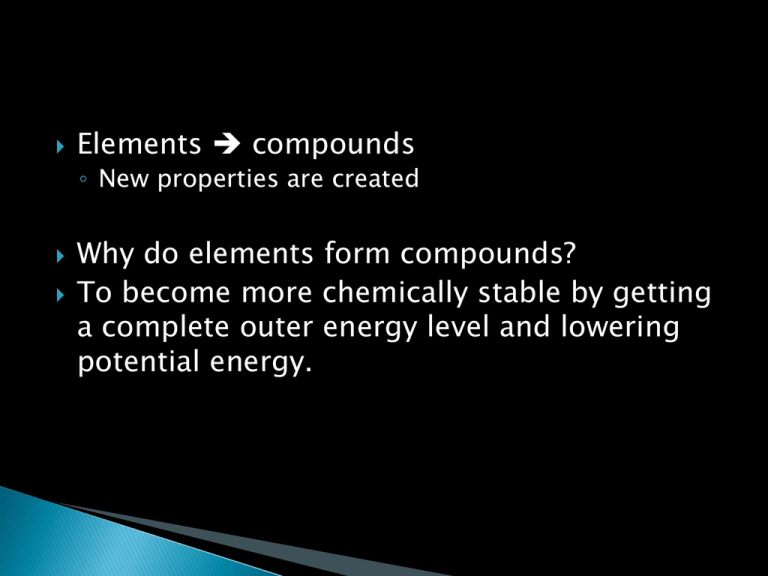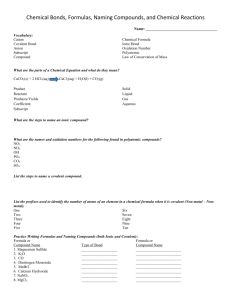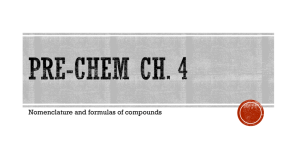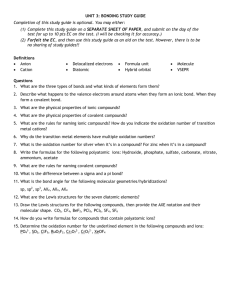Topic 4: Chemical Bonding and Formulas
advertisement

Elements compounds ◦ New properties are created Why do elements form compounds? To become more chemically stable by getting a complete outer energy level and lowering potential energy. What are chemical formulas? A formula that tells you number of atoms each element in a compound represented by symbols and subscripts Subscripts ◦ small numbers to the lower right of the chemical symbol ◦ Represents the number of atoms of that element present in the compound ***the subscript of 1 is never written in a chemical formula; it is understood since the chemical symbol is there**** Looking at the following formulas state the number of atoms for each compound. NH4OH NH4C Ag2O 2 K2SO4 Ca (NO3)2 3 Na2S 2 Al2(SO4)3 Between metals and nonmetals Cations and anions Transferring electrons Between nonmetals and nonmetals Sharing electrons Ionic compounds Covalent Compounds What are characteristics of monatomic ions? Ions formed from a single atom Cations and anions What are binary ionic compounds? Compounds composed of two elements Total number of positive and negative charges must be equal What are characteristics of polyatomic ions? Form ternary compounds (3 elements) Covalent molecules with a charge Behave as if they were one atomic ion Ammonium – NH41+ (only positive one) Hydroxide – OH1Nitrite – NO2 1Nitrate – NO3 1Sulfite – SO3 2Sulfate – SO4 2- Carbonate – CO3 2Bicarbonate – HCO3Phosphate - PO4 3Chlorate – ClO3Chlorite – ClO2Cyanide – CNAcetate – C2H3O2- Remember, oxidation numbers tell how many electrons an atom has gained, lost, or shared to become stable. Shown as superscripts. Main group elements the oxidation number is set. The transition elements and those of group 14 vary. We use oxidation numbers and their least common multiples to write formulas So, if both subscripts are divisible by the same number, they must be reduced to have formula in proper form. When writing formulas, the compound should be neutral (same number of + and - charges) Type I compounds – ionic compounds made from main group 1, 2, 13 metals and nonmetals of groups 15, 16, 17 Type II compounds – ionic compounds made from transition metal and nonmetal; named by using stock system (using Roman Numerals) Type III compounds – covalent compounds composed of 2 non-metals; named using prefixes TYPE I COMPOUNDS Write cation (metal) name first Then, write the nonmetal name. Drop the ending and add –ide to the end Ex. Nitride, sulfide, fluoride, oxide, bromide, iodide, chloride, telluride, phosphide If it is a ternary compound (with a polyatomic ion) First write name of cation Then write name of polyatomic ion TYPE II COMPOUNDS (named using stock system) If it is a transition metal, name the cation first, then put a Roman Numeral after its name to represent its oxidation number!!! ◦ Look at the subscript of the nonmetal for this information!!! Then name the anion. Remember to drop the ending and add –ide or if it is polyatomic name the polyatomic ion. Practice Naming Ionic Compounds MnO2 Ca (NO3)2 BaSO4 Cu3P2 AgCl B2O3 MgCl2 Ba (OH)2 Practice Naming Ionic Compounds-Answers MnO2 – Manganese (IV) oxide Ca (NO3)2 – Calcium nitrate BaSO4 – Barium sulfate Cu3P2 – Copper (II) phosphide AgCl – Silver (I) chloride B2O3 – Boron oxide MgCl2 – Magnesium chloride Ba (OH)2 – Barium hydroxide Bell Work 01/22/13 Name the following ionic compounds Be (OH)2 Mn (NO3)3 FePO4 Bell Work 01/22/13 Name the following ionic compounds Be (OH)2 – Beryllium hydroxide Mn (NO3)3 – Manganese (III) nitrate FePO4 – Iron (III) phosphate 1. 2. 3. 4. 5. Write the ions beside each other (first cation then anion) Write the oxidation of each as superscripts w/ charge Drop the +/- signs Crisscross superscripts so they become subscripts Reduce when possible Practice Write the formula for the following TYPE I compounds Magnesium chloride Potassium iodide Practice-Answers Magnesium chloride- MgCl2 Potassium iodide- KI Practice on your own Write the formula for the following Type I compounds Boron oxide Beryllium and Nitrogen Practice-Answers Boron oxide- B2O3 Beryllium and Nitrogen – Be3N2 Write the formula unit for the following type I compounds: Lithium nitride Sodium fluoride Bell Work 1/15/13 Write the formula unit for the following: Lithium nitride – Li3N Sodium fluoride - NaF How do you write the formula of an ionic compound with a transition metal? Written as Roman Numerals Ti (4+, 3+) Cr (2+, 3+, 6+) Mn ( 3+, 4+, 6+) Fe (2+, 3+) Co (2+, 3+) Ni (2+, 3+) Cu (2+, 1+) Ag (1+) Zn (1+, 2+) Pb (2+, 4+) Sn (1+, 2+, 4+) When it is a transition metal (type II compound). First, write the symbol of the cation. Use the roman numeral for the oxidation number. Then, write the symbol for the anion and use periodic table to determine its oxidation number. Criss-cross oxidation numbers. Reduce if necessary. Practice Write formula for the following Iron (III) oxide Zinc (II) chloride Silver (I) chloride Practice Write formula for the following Iron (III) oxide – Fe2 O3 Zinc (II) chloride – Zn Cl2 Silver (I) chloride – Ag Cl Practice Write formula for the following Copper (II) phosphide Manganese (IV) oxide Lead (IV) sulfide Practice Write formula for the following Copper (II) phosphide – Cu3 P2 Manganese (IV) oxide – Mn O2 Lead (IV) sulfide – Pb S2 How do you write the formula of an ionic compound with a polyatomic ion? Treat the polyatomic ion as one Use parenthesis around polyatomic ion Crisscross oxidation numbers to determine formula Only reduce subscripts that are outside of the parenthesis Cation Ca 2+ Mg 2+ Ba 2+ Ba 2+ Anion NO 3 – PO 4 3 OH – SO 4 2- Bell Work 1/23/13 Practice writing formulas with polyatomic ions Sodium carbonate Calcium carbonate Aluminum carbonate Sodium phosphate Calcium phosphate Aluminum phosphate Practice writing formulas with polyatomic ions Sodium carbonate – Na2CO3 Calcium carbonate – CaCO3 Aluminum carbonate – Al2(CO3)3 Sodium phosphate – Na3 PO4 Calcium phosphate – Ca3 (PO3)2 Aluminum phosphate – AlPO3 Between nonmetals and nonmetals Type III Compounds that does not contain cations and anions You do NOT crisscross to determine formula Look at the name, it tells you the formula!!!! You MUST KNOW AND USE prefixes (it tells the number of atoms of the element in the compound) DO NOT REDUCE FORMULAS!!! 1. 2. 3. 4. 5. Prefixes MonoDiTriTetraPenta- Hexa7. Hepta8. Octa9. Nona10. Deca6. RULE!!!! Do NOT use “mono” on the first element! Practice writing covalent compound formulas Dinitrogen trioxide Carbon tetrahydride Phosphorous pentoxide Disulfur trifluoride Practice writing covalent compound formulas - Answers Dinitrogen trioxide – N2O3 Carbon tetrahydride – CH4 Phosphorous pentoxide – PO5 Disulfur trifluoride – S2F3 First, use the nonmetal furthest to the left on the periodic table. If they are in the same group, write the element with the larger period number first. Write Prefix and name of element. DO NOT USE MONO!!! Then, write the second nonmetal with prefix, root, ending in –ide. Look at subscript to determine the prefix needed Bell work 01/30/13 Name the following covalent compound! PCl3 NH3 Practice naming covalent compounds PCl3 – Phosphorous trichloride NH3 – nitrogen trihydride Practice naming covalent compounds on worksheet Compounds with or without water hydrates (compounds with water) Name ionic compound as usual; but, water is covalent compound so must use prefixes Ex. CaSO4 · 2 H2O ◦ Calcium sulfate dihydrate Anhydrous (without water) Binary Acid H + element Hydro ic acid H+F Hydrofluoric acid H + Polyatomic acid (“oxo” acids) DO NOT START WITH HYDROate ic “I ate something ic-ky” Nitrate nitric acid HNO3 ite ous “I took a b-ite of something delicious” Nitrite nitrous acid HNO2 Naming Bases Name the metal CATION first; it keeps its name as listed in the Periodic Table. The polyatomic ion "hydroxide" (-OH) also keeps its name. Examples: LiOH is "lithium hydroxide" Ca(OH)2 is "calcium hydroxide" NH4OH is "ammonium hydroxide"





